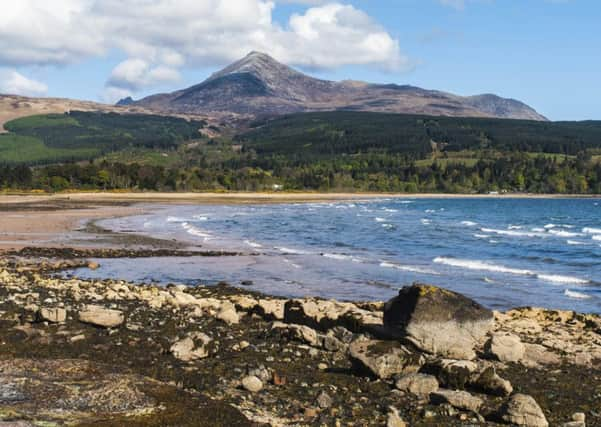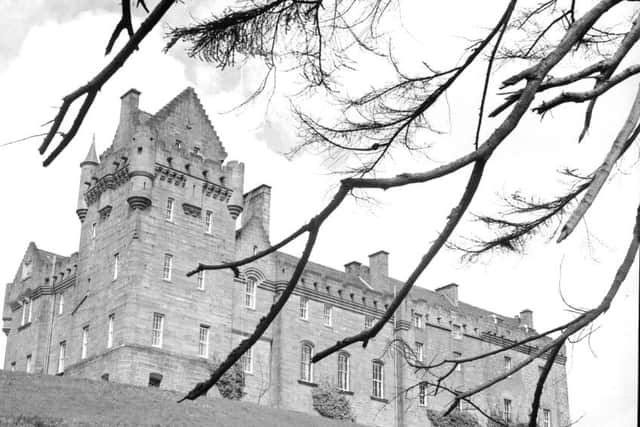Scottish mysteries: murder at the top of Goatfell


But more than 120 years after the Scotsman, John Laurie, was convicted of killing Edwin Rose on the isle of Arran’s Goatfell peak in July 1889, a deadly serious controversy still surrounds a case of “murder in the mountains”, a violent death and possible miscarriage of justice that still haunts Scottish hillwalkers to this day.
Rose’s decomposed body was found hidden in a howff, or hut built of rock, on a remote mountainside near Arran’s main town of Brodick, three weeks after he had left London for a week’s summer holiday on Scotland’s west-coast islands. His skull was shattered, his spine badly broken.
Advertisement
Hide AdAdvertisement
Hide AdLaurie, 25 years old, was subsequently arrested after two months on the run, having fled first from Arran then subsequently his Lanarkshire hometown of Coatbridge, where on his apprehension by police he attempted suicide with a cut-throat razor.


“I robbed the man,” Laurie stated on his arrest and later in his defence, “but I did not murder him.” Laurie would protest his innocence until his death more than 40 years later in 1930, age 69, in the lunatic division – as it was then known - of Perth Prison.
In a trial at Edinburgh’s High Court, held in a relative frenzy of media activity and amid massive public interest, Laurie was tried and convicted of murdering the 32-year-old Rose. He was sentenced to death, later commuted to life in prison. But with the benefit of history and hindsight, the case leaves open more questions than it ultimately answered.
The two men had met in Rothesay, on Bute, and struck a friendship. Rose, was a well-to-do fellow, working as a builder’s clerk in London and travelling with several companions.


Laurie, a pattern-maker at Springburn’s Atlas Iron Works, travelling alone and seemingly an odd fellow, was, according to The Scotsman, described in the criminal trial as “square-shouldered but slightly built, and walks with a rolling gait. His teeth are a conspicuous part of him, and are remarkably white and regular. He is exceedingly fond of dress, and was often seen in knickerbockers.”
Both men would stay at a hotel in Rothesay, but Laurie, mysteriously, would check himself in under the name of Annandale, leaving a calling card to that effect. Rose, meanwhile, was apparently warned by several of his friends that Laurie looked a nasty piece of work.After a few days climbing and walking together around Bute, Rose and Laurie sailed on the mid-afternoon ferry to Brodick, where they would then strike for the summit of Goatfell, an easily accesible peak, though the going could get treacherous in the wet weather common to the west.
Nobody knows just what transpired on the descent from the summit, but certain facts appear indisputable. Rose’s body was found purposefully concealed in a 42-stone crypt, having died of massive injuries to the head and body. Several of his belongings - a hat and walking cane - had been found further up the isolated corrie. The pair had been seen by at least five witnesses on the summit of Goatfell at about 6.20pm, but none had witnessed their descent.
Laurie was seen at the Corrie Bar in Brodick that evening, ordering drinks just before 10pm. The following day, he left the island without paying his lodging bill and was seen by several witnesses clutching a striped jacket later revealed to be Rose’s.
Advertisement
Hide AdAdvertisement
Hide AdThe discovery of Rose’s body coupled with Laurie’s apparent odious behaviour was enough to spark a manhunt. Laurie was apprehended “lurking in the vicinity” of Hamilton, The Scotsman reported, after giving up his job and apparently a girlfriend before drifting for several months between Glasgow, Aberdeen and Liverpool.
The trial, sensational in its day and held “with every manifestation of public interest”, saw queues forming outside the public gallery each day, all seeking to hear first-hand the gruesome nature of the crime.
The Crown’s ultimately successful case rested on circumstantial evidence surrounding the nature of Rose’s injuries backed by behavioural reports that convinced the jury of Laurie’s murderous intention. Laurie, meanwhile, claimed that Rose had met two others on Goatfell summit and ascended with them.
Crucially, the case skipped over details involving the cause of death. Initially the Crown had claimed Laurie battered Rose with a stone, causing his horrendous injuries, though this was easily disproved by the testimony of the Queen’s surgeon, Patrick Watson.
Not a drop of blood was found on Laurie’s clothes, or indeed anything that linked him to the murder, though clearly he had robbed Rose of his possessions.
So a fall was suggested, if not proven. A stream runs through the slippery Coire nam Fuaran, about 700ft below the lower of the two cols between North Goatfell and Mullach Buidhe, where climbers on one side could negotiate an exposed drop of 10ft, or on the other a drop of 32ft. So if Rose indeed slipped, it seems likely that Laurie stole his effects and hid the body.
Yet the murderer – if there was one at all – had clearly not sought to hide evidence. A folded cap and walking stick were found in the vicinity, the cane openly visible and placed consistent with a fall. And the solicitor-general based the charge of murder upon what he called Laurie’s “conduct” and his run from the law.
With hard evidence of murder in the balance, it seemed crucial for the Crown to play the behavioural card as Laurie’s motive. In reality, the Crown had proved nothing, though the jury convicted by a majority of one after just 45 minutes’ deliberation. The verdict resonated throughout the island community and the mainland, as well as sending a chill through hillwalking circles.
Advertisement
Hide AdAdvertisement
Hide Ad“The obvious idea is that an opportunity came where Laurie could give Rose a push and then rob him and then take his gear, and that somebody who lies a lot is inevitably under suspicion,” says Robin Campbell, archivist of the Scottish Mountaineering Club, who has written extensively about the case.
“But why would Laurie kill him? The evidence is circumstantial and weak, and, my guess, it was an accident. Rose died in the accident, Laurie decided to take what he had and stuff him under a boulder. The medical evidence presented by the Crown was also dubious at best.”
Noting that the peak is “only an hour” from Arran’s Glen Sannox, Campbell says the spot remains popular among hillwalkers today. You can, in fact, spend a night in the same howff in which Rose was found, though Campbell doesn’t recommend it.
“Murder in the hills is easy,” Campbell says, adding, “who can prove a push or a fall?”.
DOWNLOAD THE SCOTSMAN APP ON ITUNES OR GOOGLE PLAY
